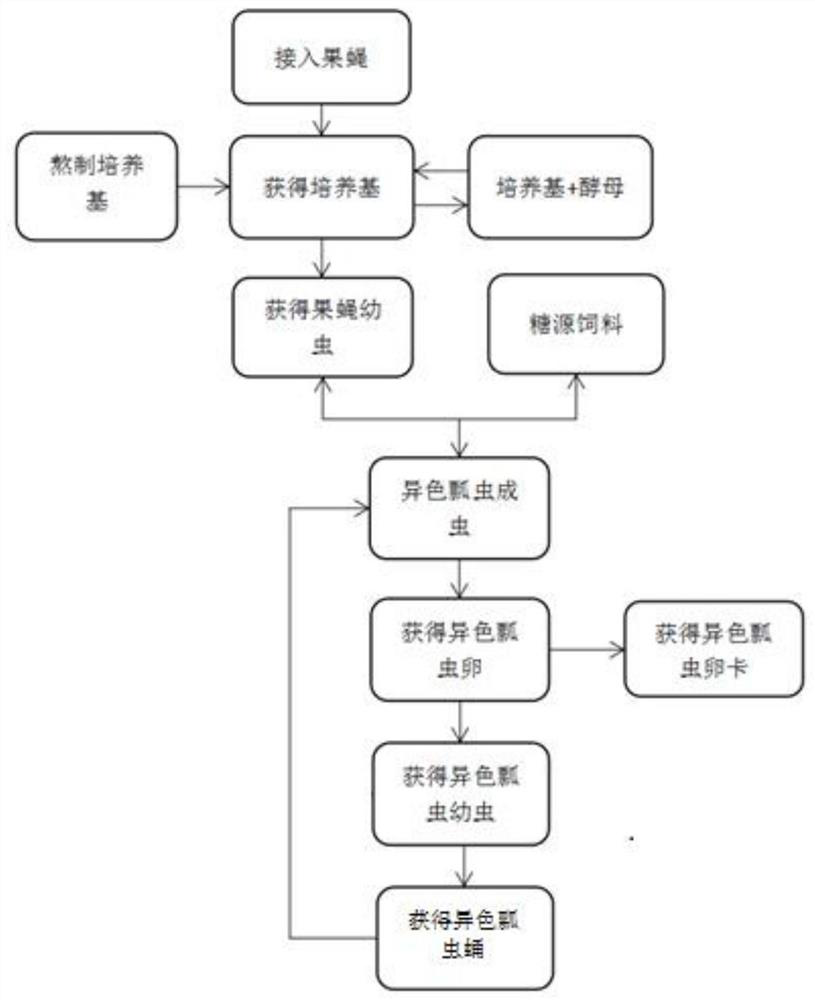Feed for natural enemy ladybirds with high laying proliferation rate and application of feed
A natural enemy ladybug, multiplication rate technology, applied in the field of feed with high egg-laying multiplication rate of natural enemy ladybug, can solve the problems of low survival rate of larvae, decreased reproductive ability, long feeding cycle, etc., and achieve the effect of low fecundity
- Summary
- Abstract
- Description
- Claims
- Application Information
AI Technical Summary
Problems solved by technology
Method used
Image
Examples
Embodiment 1
[0041] Embodiment 1 Raises Heterochromia with Drosophila larvae+sucrose solution
[0042] (1) Place 1 pair of Heterochromia in an 8*8cm plastic box covered with gauze, place absorbent cotton dipped in 10% sucrose water, and white toilet paper in it for laying eggs. Only 10-15 Drosophila larvae were fed. Feed every 1 day, add sugar water every 2 days using a plastic dropper, and replace the absorbent cotton every 10 days. Egg masses were collected every 2 days. A total of 106 eggs were collected in 5 days.
[0043] (2) Take out the white toilet paper with eggs, and place them under the conditions of 26±1° C., RH=75±5%, 16L:8D light conditions until hatching, and obtain 95 Heterochromia larvae.
[0044](3) Take 30 hatched larvae and place them individually in a 29mm*104mm plastic bottle, pierce holes in the plastic bottle cap, and add absorbent cotton dipped in 10% sucrose water therein. Feed 3-5 fruit fly larvae per day for 1-2 instar larvae, 10-15 fruit fly larvae per day ...
Embodiment 2
[0045] Embodiment 2 Raising Heterochromia with Drosophila larvae+honey solution
[0046] (1) Place 1 pair of heterochromia ladybugs in an 8*8cm plastic box covered with gauze, place absorbent cotton dipped in 10% honey water, and white toilet paper therein, for its laying eggs, according to daily Only 10-15 Drosophila larvae were fed. Feed every 1 day, add sugar water every 2 days using a plastic dropper, and replace the absorbent cotton every 10 days. Egg masses were collected every 2 days. A total of 89 eggs were collected in 5 days.
[0047] (2) Take out the white toilet paper with eggs, and place them under the conditions of 26±1° C., RH=75±5%, and 16L:8D light conditions until they hatch, and obtain 77 Heterochromia larvae.
[0048] (3) Take 30 hatched larvae and place them individually in a plastic bottle of 29mm*104mm, and pierce holes in the plastic bottle cap, add absorbent cotton dipped in 10% honey water, and feed the 1-2 instar larvae daily Each 3-5 fruit fly l...
Embodiment 3
[0049] Example 3 Raising Heterochromia with Drosophila larvae+fructose solution
[0050] (1) Place 1 pair of Heterochromia in a plastic box of 8*8cm covered with gauze, place therein absorbent cotton dipped in 10% fructose water, and white toilet paper, for its laying eggs, according to daily Only 10-15 Drosophila larvae were fed. Feed every 1 day, add sugar water every 2 days using a plastic dropper, and replace the absorbent cotton every 10 days. Egg masses were collected every 2 days. A total of 67 eggs were collected in 5 days.
[0051] (2) Take out the white toilet paper with eggs, and place them under the conditions of 26±1° C., RH=75±5%, 16L:8D light conditions until hatching, and obtain 59 Heterochromia larvae.
[0052] (3) Take 30 hatched larvae and place them separately in 29mm*104mm plastic bottles, and pierce holes in the plastic bottle caps, add absorbent cotton dipped in 10% fructose water, and feed the 1-2 instar larvae every day. Each 3-5 fruit fly larvae, ...
PUM
 Login to View More
Login to View More Abstract
Description
Claims
Application Information
 Login to View More
Login to View More - R&D
- Intellectual Property
- Life Sciences
- Materials
- Tech Scout
- Unparalleled Data Quality
- Higher Quality Content
- 60% Fewer Hallucinations
Browse by: Latest US Patents, China's latest patents, Technical Efficacy Thesaurus, Application Domain, Technology Topic, Popular Technical Reports.
© 2025 PatSnap. All rights reserved.Legal|Privacy policy|Modern Slavery Act Transparency Statement|Sitemap|About US| Contact US: help@patsnap.com

